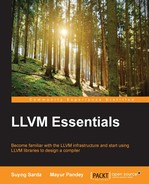LLVM provides a powerful intermediate representation for efficient compiler transformations and analysis, while providing a natural means to debug and visualize the transformations. The IR is so designed that it can be easily mapped to high level languages. LLVM IR provides typed information, which can be used for various optimizations.
In the last chapter, you learned how to create some simple LLVM instructions within a function and module. Starting from simple examples such as emitting binary operations, we constructed functions in a module and also created some complex programming paradigms such as if-else and loops. LLVM provides a rich set of instructions and intrinsics to emit a complex IR.
In this chapter, we will go through some more examples of LLVM IR which involve memory operations. Some advanced topics such as aggregate data types and operations on them will also be covered. The topics covered in this chapter are as follows:
- Getting the address of an element
- Reading from the memory
- Writing into a memory location
- Inserting a scalar into a vector
- Extracting a scalar from a vector
Memory is an important component of almost all computing systems. Memory stores data, which needs to be read to perform operations on the computing system. Results of the operations are stored back in the memory.
The first step is to get the location of the desired element from the memory and store the address in which that particular element can be found. You will now learn how to calculate the address and perform load-store operations.
